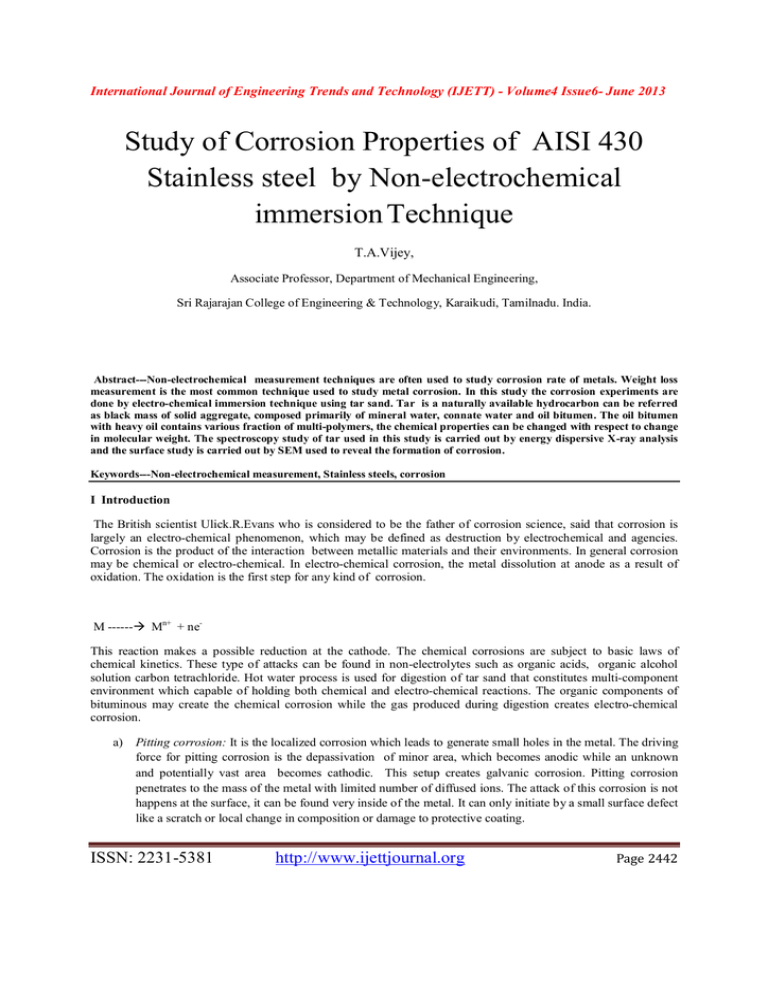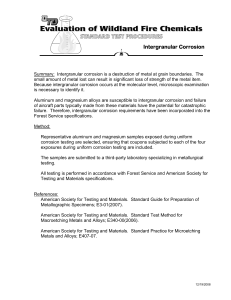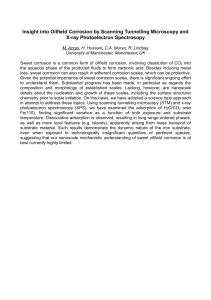Study of Corrosion Properties of AISI 430 immersion Technique
advertisement

International Journal of Engineering Trends and Technology (IJETT) - Volume4 Issue6- June 2013 Study of Corrosion Properties of AISI 430 Stainless steel by Non-electrochemical immersion Technique T.A.Vijey, Associate Professor, Department of Mechanical Engineering, Sri Rajarajan College of Engineering & Technology, Karaikudi, Tamilnadu. India. Abstract---Non-electrochemical measurement techniques are often used to study corrosion rate of metals. Weight loss measurement is the most common technique used to study metal corrosion. In this study the corrosion experiments are done by electro-chemical immersion technique using tar sand. Tar is a naturally available hydrocarbon can be referred as black mass of solid aggregate, composed primarily of mineral water, connate water and oil bitumen. The oil bitumen with heavy oil contains various fraction of multi-polymers, the chemical properties can be changed with respect to change in molecular weight. The spectroscopy study of tar used in this study is carried out by energy dispersive X-ray analysis and the surface study is carried out by SEM used to reveal the formation of corrosion. Keywords---Non-electrochemical measurement, Stainless steels, corrosion I Introduction The British scientist Ulick.R.Evans who is considered to be the father of corrosion science, said that corrosion is largely an electro-chemical phenomenon, which may be defined as destruction by electrochemical and agencies. Corrosion is the product of the interaction between metallic materials and their environments. In general corrosion may be chemical or electro-chemical. In electro-chemical corrosion, the metal dissolution at anode as a result of oxidation. The oxidation is the first step for any kind of corrosion. M ------ Mn+ + neThis reaction makes a possible reduction at the cathode. The chemical corrosions are subject to basic laws of chemical kinetics. These type of attacks can be found in non-electrolytes such as organic acids, organic alcohol solution carbon tetrachloride. Hot water process is used for digestion of tar sand that constitutes multi-component environment which capable of holding both chemical and electro-chemical reactions. The organic components of bituminous may create the chemical corrosion while the gas produced during digestion creates electro-chemical corrosion. a) Pitting corrosion: It is the localized corrosion which leads to generate small holes in the metal. The driving force for pitting corrosion is the depassivation of minor area, which becomes anodic while an unknown and potentially vast area becomes cathodic. This setup creates galvanic corrosion. Pitting corrosion penetrates to the mass of the metal with limited number of diffused ions. The attack of this corrosion is not happens at the surface, it can be found very inside of the metal. It can only initiate by a small surface defect like a scratch or local change in composition or damage to protective coating. ISSN: 2231-5381 http://www.ijettjournal.org Page 2442 International Journal of Engineering Trends and Technology (IJETT) - Volume4 Issue6- June 2013 b) Crevice corrosion: It is also a similar form of corrosion, which occurs at confined spaces to which the access of working fluid from the surrounding is limited. This type of corrosion forms in the gap, contact areas between the parts, inside cracks and seams, spaces filled with deposits and under sludge piles. The mode of attack may be in the form of formation of pits, filiform corrosion, intergrannular attack and stress corrosion cracking. Metals depending on their characteristic nature and surrounding environment will leads to different types of corrosion. Stainless steel is a group of iron based alloy with at least 11% Cr with other alloying components such as C,Mn,Si,Ni,Mo,Ti and N. The high percentage of Cr is the key alloying element to prevent the alloy from corrosion. The alloy AISI 430 is a ferritic alloy which is one of the corrosion resistant alloy used for industrial application at high temperatures. II Experimental procedure The alloy used in this study is AISI 430 which is obtained in the form of scrap, its chemical composition is given below. Table I: Energy dispersive X-ray analysis of AISI 430 sample (Atomic concentration in atom % ) Stainless Cr Ni Ti Mn Al - - - Al P S 14.18 0.89 7.70 Si Fe C Steel AISI 430 16.8 - - 83.22 0.134 Table II: Energy dispersive X-ray analysis of Tar sand (Atomic concentration in atom % ) Ca Na 2.70 1.88 Mg 0.78 Si Ti 71.15 0.69 Corrosion coupons are made from the sample metal and grounded to 600 grits starting with the standard emery grades of 240,320 and 400 grits. After this, the coupons are polished to mirror-like polish ,then in order to remove the organic substances on the surface of the coupons, they are washed with non-bleaching scurrying power, swabbed with water and then acetone. The initial weight is made by a chemical balance to and recorded nearest to 0.1mg. Few of the samples are not weighed and used to take metallograph after proper etching. pH measurement is also consider in this study through out the experiment for 48 hours, before that the pH meter is sandardized by immersing in to the distilled water and the meter is adjusted to 7 at room temperature. Then the pH meter is dipped in to the medium to measure pH. A pulp of tar , sodium hydroxide and water were arranged to act as corrosive medium. The tar was reduced in to smaller size ie., less than 9.0mm and it was dried to 1000C in a oven. Aqueous ISSN: 2231-5381 http://www.ijettjournal.org Page 2443 International Journal of Engineering Trends and Technology (IJETT) - Volume4 Issue6- June 2013 solutions of 0.58M of Sodium hydroxide was kept in a container. Then the measured quantity of tar was added in to the container and properly mixed. After this arrangement, the corrosive media was heated up to 950C. III Experimental setup The experimental setup was made as given above and the conditions for hot water tar digestion are carefully.The tar deposit was considered as the feed source with NaOH as wetting agent kept at 950C in hot water. 70% weight of tar was used as solids for a duration of 15 minutes. The NaOH concentration was taken as 0.58% mol per litre. The feed size was kept extruded with 9.5mm. The coupons are used to expose themselves to corrosion environment up to 20 days. IV Results and Discussions It was observed that the metal showed a greater tendency for pitting corrosion and the micrograph was taken for further study. Figure 1 is the micrograph of the corroded surface of the metal, it shows wide spread of pits across the surface. Figure 2 shows that some of the pits developed due to crevice corrosion under the tar sand deposit that hit the surface of the sample. Some of the pits arose from the pitting corrosion in the matrix of the metal and some from the presence some elements in the tar sand. As far as the tar sand is concerned, numerous galvanic cells would have been developed between the iron of the steel and the vanadium nickel metals present in the . Here the iron/steel acts as anode and the trace metals like V or Ni act like cathode. Therefore the metal ion depositions are made possible cathodic reaction in tar sand reactions. The sacrificial cathodic protection of metal surface are made by the electrode potentials of the other trace elements with respect to that of the presence of iron in steel and the respective reactions can be written as below: Reactions at the anode: Ca = Ca2+ + 2eK = K+ + 2eMg = Mg2+ + 2eNa = Na+ + eReactions at the cathode: 1/2H2O + H2O + 2e- = 2OH (dissolved oxygen makes an influence here) 2H+ + + e- = H2(g) (dissociation of organic acids in the medium produces excess H ions) ISSN: 2231-5381 http://www.ijettjournal.org Page 2444 International Journal of Engineering Trends and Technology (IJETT) - Volume4 Issue6- June 2013 Fig 1. SEM of corroded AISI 430 Stainless steel after 20 days exposure (1000x) Fig2. SEM of corroded AISI 430 Stainless steel after 20 days exposure (5000x) From the experimental result and micrograph analysis, it can be concluded that the AISI 430 stainless steel is Susceptible to pitting and crevice corrosion in the tar medium. It implies that this steel is not more corrosive resistant. ISSN: 2231-5381 http://www.ijettjournal.org Page 2445 International Journal of Engineering Trends and Technology (IJETT) - Volume4 Issue6- June 2013 V References [1] Fontana,C.M. and Greene.N.D.(1983) Corrosion International book company Engineering,2nd Edition, McGraw Hill [2] Sepuldeva,J.F. and Miller,J.D.(1978) Extraction of Bitumen from Utah tar by hot water digestion flotation technique, Mining Engineering Vol.17,(1-20),pp 57-65 [3] International stainless steel forum, 2007.The ferritic solution, properties / advantagesApplications / the essential guide to ferritic stainless steel,p.68 [4] Miller,J.D. and Misra,M.(1982) Hot water process development for Utah tar , Fuel processing technology, Vol.6,pp 27-59 [5]Umoru.L.E.,et.al, Corrosion study of AISI 304, AISI 321 and AISI 430 Stainless Steels in a tar sand digester, Journal of mineral and material characterization & engineering, Vol.7,No.14, pp 291299,2008 [6] Corrosion (two volumes), L. L. Shreir, R. A. Jarman, and G. T. Burstein , ButterworthHeinemann, Oxford, Boston, 1994. [7] Corrosion control and treatment manual, Nasa.gov, publication text ,November 1,1994. [8] Atlas of Electrochemical Equilibria in Aqueous Solutions (2 nd edition), M. Pourbaix, National Ass ociation of Corrosion Engineers, Houston TX, 1974. [9]Collins, A.G. (1975) Geochemistry of the oil field waters, Elsevier Scientific Publishing Company, New York, pp194. [10] Advances in Localized Corrosion: NACE-9, H. S. Isaacs, U. Bertocci, J. Kruger, and S. Smialowska, National Association of Corrosion Engineers, Houston TX, 1990. [11] Koser, H.J.K. (1980) corrosion of metals in carbon tetrachloride containing solvent, Analyst pp123 [12] Principles and Prevention of Corrosion (2 nd edition), D. A. Jones, Prentice Hall, Upper Saddle River NJ, 1996. ---------------- ISSN: 2231-5381 http://www.ijettjournal.org Page 2446







